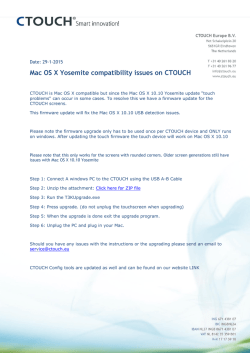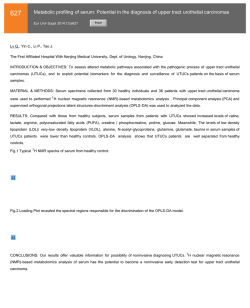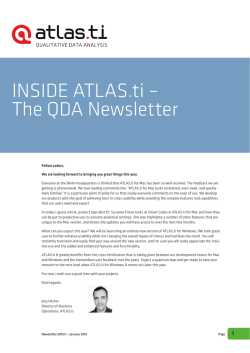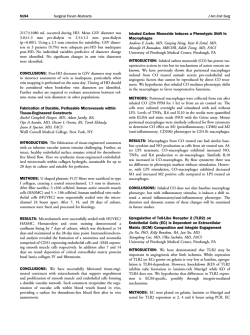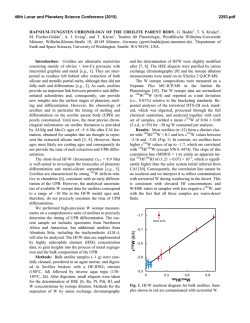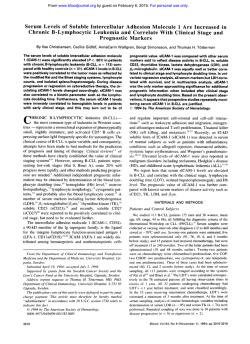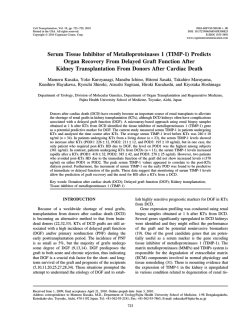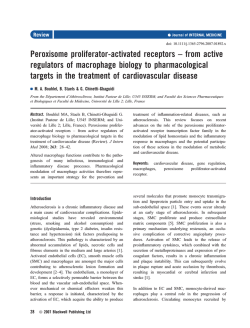
Induction of Human Monocyte to Macrophage Maturation In
RAPID COMMUNICATION Induction of Human Monocyte to Macrophage Maturation In Vitro by 1,25-Dihydroxyvitamin D, By Marina Kreutz and Reinhard Andreesen Cells of the mononuclear phagocyte system arise from circulating blood monocytes (MO) that undergo further maturation on leaving the vasculature and migration into the various tissues and body cavities. This terminal differentiation step is also observed in vitro when blood MO are cultured in the presence of serum. Yet, the inducing signals present in serum are not defined. We have established primary cultures from elutriation-purified blood MO and found that the active metabolite of vitamin D, 1.25dihydroxyvitaminD, (1,25(OH),D,) could induce maturation of MO to macrophages (MAC) in the absence of any serum proteins. Cells were cultured for 7 days with AB-group serum or ,1,25(OH),D,, respectively, and MO maturation analyzed by morphology, functionalactivity, and the expression of lineage-restricted maturation-associated antigens (MAX.l, MAX.3). At an optimal concentration of IO-' mol/L, 1,25(OH),D, promoted the development of fully differentiated MAC whose phenotype and functional competence in terms of cytokine release (tumor necrosisfactor a. interleukin-6, fibronectin, and lysozyme) was comparable with MAC grown in serum. In conclusion, our data may add to the immunoregulatory potential of 1,25(OH),D,. which may play an essential role in the ontogeny of the mononuclear phagocyte system. 0 1990 by The American Society of Hematology. C expression of maturation-associated (MAX) antigens but also by the cytokine repertoire of 1,25(0H),D3-induced MAC. IRCULATING BLOOD monocytes (MO) provide a common precursor pool which gives rise to the heterogenous family of cells that constitute the human mononuclear phagocyte system (MPS).' The terminal differentiation of blood M O to mature macrophages (MAC) can also be followed in Here, when cultured in the presence of serum M O undergo a characteristic change in morphology, cytochemistry, and function, a process considered to be similar to the differentiation of M O in vivo. M O maturation in vitro is associated with the expression of specific antigens not found on blood M O but present on Their analysis is used to more objectively define maturation in primary cultures of human hf0.9,'0 N o consistent knowledge presently exists on the regulation of M O to MAC transformation. Serum needs to be present in M O cultures for successful maturation into MAC, neither known hematopoietins nor other yet defined cytokines are able to replace serum. Only macrophage colony-stimulating factor (M-CSF) might be of importance as a competence and survival factor for M O in vitro" (Brugger W, Kreutz M, Andreesen R: Macrophage colony-stimulating factor is required for monocyte survival and acts as a cofactor for their terminal differentiation to macrophages in vitro. J Leukoc Biol, in press 199 1). The major biologically active metabolite of vitamin D,, 1,25-dihydroxyvitamin D,-( 1,25(OH),D,), has found increasing attention since functional receptors have been found to be ubiquitous in tissue di~tribution.'~.'~ Beside the classical role of 1,25 (OH), D, in mineral homeostasis this molecule was In addition, shown to be an immunoregulatory several studies using tumor cell lines16-18 as well as cultures of normal bone marrow precursors" have shown I ,25(OH),D, to induce cell differentiation toward the macrophage lineage. There is also preliminary evidence that 1,25(OH),D, supports the serum-induced differentiation of blood MO.,' In this study, the effect of 1,25(OH),D, on the induction and promotion of terminal human M O to MAC differentiation in serum-free culture was investigated. M O were found to develop all the characteristics of mature MAC with 1,25(OH),D, being the only additive to the culture medium. Successful terminal differentiation was shown not only by the Blood, Vol76, No 12 (December 15). 1990: pp 2457-2461 MATERIALS AND METHODS MO culture. Peripheral blood mononuclear cells (MNC) were separated from leukapheresisproducts of healthy donors by density gradient centrifugation over Ficoll. MO were isolated from MNC by countercurrent centrifugal elutriation in a J6M-E centrifuge and a JE-5 rotor (Beckman, Miinchen, Germany) at 2,500 rpm with a standard chamber and a flow rate of 20 mL/min as previously described." Elutriated MO were of greater than 90% purity as estimated by morphology and expression of CD14 antigen. Purified MO were resuspended in RPMI 1640 (Biochrom, Berlin, Germany) supplemented with 5 x lo-' mol/L mercaptoethanol, vitamins, antibiotics, pyruvat, and nonessential amino acids. MO were cultured in 96-well microtiterplates (Greiner, Niirtingen, Germany) at 2x cells/0.2 mL supplementedRPMI 1640with or without 5% AB-group serum or 1,25(OH),D, (Hoffmann-La Roche, Basel, Switzerland) at various concentrations. 1,25(OH),D, was dissolved in 100% ethanol to a stock concentration of 2- x lo-' mol/L and stored at -2OOC. The various concentrations were obtained by diluting the stock solution in RPMI 1640.After 7 days medium was removed and cells were cultured with fresh, serum-free supplemented RPMI 1640 without or with 1 pg/mL lipopolysaccharide (LPS) (Salmonella abortus equi, kindly provided by C. Galanos, Max-Planck-Inst., Freiburg, Germany) for 24 hours. Supernatants were harvested and stored at -2OOC. From the Medizinische Klinik der Albert-Ludwig-Universitat, Freiburg i.Brsg.. Germany. Submitted June 13,1990; accepted October 1,1990. Supported by a grant from Deutsche Forschungsgemeinschaft AN1 1 1 . R.A. is a holder of a Heisenberg Scholarship awarded by the Deutsche Forschungsgemeinschaft. Address reprint requests to Reinhard Andreesen. MD. Medizinische Klinik, Hugstetterstr.55,0-7800 Freiburg, Germany. The publication costs of this article were defrayed in part by page charge payment. This article must therefore be hereby marked "advertisement" in accordance with 18 U.S.C.section 1734 solely to indicate this fact. 0 1990 by The American Society of Hematology. 0006-4971/90/7612-0032$3.00/0 2457 2458 KREUTZ AND ANDREESEN Immunophenotype analysis. Subsequent to supernatant collection cell monolayers were fixed with 0.05% glutaraldehyde and surface antigen expression was measured by cell enzyme-linked immunosorbent assay (ELISA) as described el~ewhere.'.'~ The following antibodies were used: anti-j32-microglobulin (Becton Dickinson, Rodermark, Germany), MAX.1 and MAX.3 (own laboratory).' Optical density (OD) was measured at 492 nm, corrected by the OD of specificity controls, mean of triplicates. Data are given as antigen expression index (AEI), which was calculated by dividing the OD values of the respective antigen by the OD value for 02-microglobulin expression times 100. Functional analysis. Supernatants were pooled from 15 individual wells and tested for tumor necrosis factor a (TNFa) by ELISA (T Cell Science, Inc, Cambridge, MA). Fibronectin was also determined by ELISA (own development). Lysozyme was measured photometrically (Behringwerke, Marburg, Germany). Interleukin-6 (IL-6) activity was tested in a bioassay using the IL-6-dependent cell line B9 (kindly provided by Dr Aarden, Amsterdam, The Netherlands)." ing secretory products: lysozyme, fibronectin, IL-6, and TNFa. As shown in Fig 2, 1,25(OH),D3-induced MAC produce large amounts of IL-6 when stimulated with LPS. The secretion is about sixfold higher than serum-derived MAC. TNFa, which increases 10-fold on MO to MAC maturation, is in the same range in serum and 1,25(0H),D3-induced MAC (Fig 2). Lysozyme and fibronectin are secreted constitutively in similar amounts by 1,25(OH),D3- and seruminduced MAC, respectively (Fig 3). The optimal dose of 1,25(OH),D3 to induce functionally competent MAC in terms of cytokine release was 1 to 100 nmol/L 1,25(OH),D3, which is similar to what was observed for the expression of maturation-associated antigen. Thus, from phenotypic and functional analysis 1,25(0H),D3-induced MAC resemble mature serum-derived MAC. RESULTS DISCUSSION The in vitro differentiation of circulating blood MO to MAC occurs in the presence of serum and can be followed by the expression of maturation-associated antigens of the MAX series that are absent on blood MO but expressed on terminally differentiated MAC. As shown in Fig 1, 1,25(OH),D3 can substitute for serum to promote the differentiation of M O into MAC as determined by the expression of MAX.1 and MAX.3 antigens. In the range of 1 to 100 nmol/L 1,25(OH),D3 MAX antigen expression was comparable with that of serum-derived MAC. There was no maturation in the absence of serum or 1,25(OH),D3. This result was also evident from morphology: in serum-free cultures cells stayed monocytoid in morphology, whereas MO treated with serum or 1,25(OH),D, became larger, more spread, and developed macrophage-typical morphology (not shown). These phenotypic and morphologic changes taking place during the maturation from MO into MAC are accompanied by characteristic changes in the biosecretory repertoire of the cell. MO were cultured for 7 days with or without serum or 1,25(OH),D3 and day-7 supernatants analyzed for the follow- The in vitro maturation of blood MO into MAC is a useful model to study regulatory signals and functional consequences of this differentiation process, which seems to be central in the ontogeny of the MAC cell system.' Factors present in serum and responsible for this differentiationinducing activity have not been identified yet. There have been reports implicating M-CSF," IL-4,,, and human gamma globulins23as possible mediators for MAC differentiation. However, none of these substances had the capacity to induce MAC differentiation in our culture system comparable with serum though M-CSF proved to be essential for MO survival in vitro. Our results presented here clearly show that the active metabolite of vitamin D3, 1,25(OH),D3, induces terminal differentiation of circulating blood MO to mature MAC in vitro. Macrophages developing in the presence of 1,25(OH),D, expressed maturation-associated antigens and secreted lysozyme and fibronectin with the latter being restricted specifically to MAC at differentiation stages beyond the blood MO In addition, the functional competence of 1,25(0H),D3-induced MAC is shown by their AEI (%) 120 + MAX.l i% 100 80 60 40 20 0 0 -13 -12 -11 -10 -9 -8 log 1,25 (OH12 VITD3 (MI -7 -6 Fig 1. Induction of MO to MAC maturation by 1,25(0H),D,. Elutriated MO were cultured with 125(OH),D, for 7 days in microtiterplates. Maturation is analyzed by the expression of MAX.1 and MAX.3 antigens given as AEI, mean of triplicate values, SD 4 5 % . Data are from one representative experiment out of three. 2459 INDUCTION OF MAC MATURATION BY VITAMIN D, IL-6 (U/ml) TNF-alpha (ng/ml) 25 2000 1500 I IL-6 TNF-alpha 20 15 looo! 500 Fig 2. LPS-induced secretion of IL-6 and TNFa in 1,25(OH),D3-induced MAC. MO were cultured for 7 days with serum or 1,25(OH),D,, respectively. Medium was removed and MAC were cultured for 24 hours with fresh medium containing 1 pg/mL LPS abortus equi. Supernatants were then tested for cytokines. 10 1 5 ., n 0 -10 -11 -9 -8 -7 -6 serum log 1,25 (OH12 VITD3 (MI are in a dose range about 10- to 100-fold higher than cytokine repertoire, eg, high release of TNFa and IL-6 and measured in the AB-group sera used in our experiments the absence of IL-lP (not shown) a feature common to successful MO to MAC differentiation in ~itro.~~*~'-Although(mean of six different donors 1.1 x lo-'' mol/L, SD = 5 x lo-" mol/L; measured by Limbach, Schmidt-Gayk, Heidel1,25(OH),D3 has been long known as an inducer of monoberg, Germany). This level of 1,25(OH),D3 is comparable cytic differentiati~n'~-~' and osteoclast generation:' most with serum levels reported by other groups (1 x lo-'' published work was concerned with the differentiation of m ~ l / L ) . *Yet ~ it should be noted that this is an effect induced tumor cell lines and early hematopoietic precursor cells. by 1,25(OH),D3 alone in serum-free culture, whereas in There are some lines of evidence that MO to MAC differenserum other synergistic factors have to be discussed that may tiation is differently regulated than monocytic differentiation potentiate the effect of 1,25(OH),D3. It should also be of tumor cell lines. First, the differentiation induced in tumor mentioned that for all in vitro activities attributed to cell lines seems not to proceed beyond the blood MO stage 1,25(OH),D,, a similar dose is rep~rted.".'~The negative (unpublished observation). Secondly, the differentiationeffect of high doses of 1,25(OH),D3 most likely relates to an inducing stimulant for tumor cells, interferon-y (IFNy), has unspecific membrane effect because secosteroids like opposite effects on blood MO, eg, suppresses serum-induced 1,25(OH),D3 are highly lipophilic substances. According to maturation to MAC." In comparison with serum-containing this finding is the observation that high doses of the metabocultures 1,25(OH),D3-inducedMAC maturation resulted in lite 25(OH)D3 were found to be toxic for MO, too (data not a considerable smaller cell recovery (20% to 40% of serumshown in detail). induced MAC). Additional factors may be present in serum Elevated serum levels of 1,25(OH),D, have been shown in to promote cell survival. Studies are in progress to identify diseases such as sarcoidosis and macrophages associated with those cofactors that might be present in the albumin fraction granuloma tissue secrete 1,25(OH),D3in vitro.30It is conceivas shown by preliminary experiments. able that MAC-derived 1,25(OH),D3 may serve as an It should be noted that the effects observed in our system isozyme (ug/ml) fibronectin (ng/rr 3.: I 600 lysozyme 500 fibronectin 2.5 400 2 300 1.5 200 I 100 0.5 0 I -10 -9 -8 -7 -6 log 1.25 (OH)2 VitD3 (M) serum Fig 3. Constitutive secretion of lysozyme and fibronectin by 1,25(0H),D,-induced MAC. For details see legend to Fig 2. Supernatants were generated without the addition of stimuli. 2460 KREUTZ AND ANDREESEN autocrine signal to promote MO to MAC generation a n d m a y even be implicated in the pathophysiology of this chronic inflammatory reaction by inducing t h a t type of MAC characteristic of a granulomatous inflammation. Chronic bacterial infection may support this autoregulatory circuit as LPS are potent stimuli of vitamin D 3 metaboli~m.~’ Similarly, IFNy stimulates the synthesis of 1,25(OH),D3 in normal human MAC3’ It should also be noted t h a t MAC obtained from vitamin D3-deficient mice showed an impaired response to activation for tumor c y t o t ~ x i c i t y . ’In~ view of our data this functional defect might well be related to incomplete MO maturation as both the spontaneous and IFNy-activated tumor cytotoxicity depend crucially on a successful differentiation of blood MO to mature MAC.34 I n conclusion, t h e a c t i v e v i t a m i n D 3 m e t a b o l i t e 1,25(OH),D3 appears to participate in the regulation of MAC ontogeny not only at t h e level of committed stem cells but also as inducer of normal MO to MAC maturation. Especially the latter activity, through the multifold interactions of the MPS with other cell systems, may have widespread implications for normal homeostasis as well as to understand t h e pathophysiology of abnormal vitamin D 3 metabolism as it is seen in granulomatous disorders, hematopoietic neoplasia, and chronic renal failure. ACKNOWLEDGMENT We acknowledge the excellent technical assistance of Annegret Rehm. REFERENCES 1. van Furth R: Current view on the mononuclear phagocyte system. Immunobiology 161:178, 1982 2. van der Meer JWM, van de Gevel JS, van Oud Alblas AB, Kramps JA, van Zwet TL, Leijh PC, van Furth R: Characteristics of human monocytes cultured in the Teflon culture bag. Immunology 47:617, 1982 3. Johnson WD, Mei B, Cohn ZA: The separation, long term cultivation, and maturation of the human monocyte. J Exp Med 146:1613,1977 4. Musson RA: Human serum induces maturation of human monocytes in vitro. Am J Pathol 111:3, 1983 5. Andreesen R, Picht J, Lohr GW: Primary cultures of human blood-born macrophages grown on hydrophobic teflon membranes. J Immunol Methods 56:295,1983 6. Andreesen R, Osterholz J, Bodemann H, Bross KJ, Costabel U, Lohr GW: Expression of transferrin receptors and intracellular ferritin during terminal differentiation of human monocytes. Blut 49:195, 1984 7. Clarkson SB, Ory PA: Developmentally regulated IgG Fc receptors on cultured human monocytes. J Exp Med 167:408,1988 8. Andreesen R, Bross KJ, Osterholz J, Emmrich F Human macrophage maturation and heterogeneity: Analysis with a newly generated set of monoclonal antibodies to differentiation antigens. Blood67:1257,1986 9. Andreesen R, Mackensen A, Osterholz J, Brugger W, Lohr GW: Microculture assay for human macrophage maturation in vitro: Cell ELISA analysis of differentiation antigen expression. Int Arch Allergy Appl Immunol86:281, 1988 10. Andreesen R, Brugger W, Scheibenbogen C, Kreutz M, Leser HG, Rehm A, Lohr GW: Surface phenotype analysis of human monocyte to macrophage maturation. J Leukoc Biol47:490, 1990 11. Becker S, Warren MK, Haskill S: Colony-stimulating factorinduced monocyte survival and differentiation into macrophages in serum-free cultures. J Immunol 139:3703, 1987 12. Minghetti PP, Norman AW: 1,25(0H),-vitaminD3-receptors: Gene regulation and genetic circuitry. FASEB J 2:3043, 1988 13. Prowedini DM, Tsoukas CD, Deftos LJ, Manolagas SC: 1,25-dihydroxyvitamin D, receptors in human leukocytes. Science 221:1181,1983 14. Reichel H, Koeffler HP, Norman AW: The role of the vitamin D endocrine system in health and disease. N Engl J Med 13:980, 1989 15. Rigby WFC: The immunobiology of vitamin D. Immunol Today 954,1988 16. Zuckerman SH, Suprenant YM, Tang J: Synergistic effect of granulocyte-macrophage colony-stimulating factor and 1,25-dihydroxyvitamin D, on the differentiation of the human monocytic cell lineU937. Blood 71:619, 1988 17. Abe E, Miyaura C, Sakagami H, Takeda M, Konno K, Yamazaki T, Yoshiki S, Suda T: Differentiation of mouse myeloid leukemia cells induced by 1,25-dihydroxyvitamin D,. Proc Natl Acad Sci USA 78:4990,1981 18. Bar-Shavit Z, Teitelbaum SL, Reitsma P, Hall A, Pegg LE, Trial J, Kahn AJ: Induction of monocytic differentiation and bone resorption by 1,25-dihydroxyvitamin D,. Proc Natl Acad Sci USA 805907, 1983 19. Koeffler HP, Amatruda T, Ikekawa N, Kobayashi Y, DeLuca H F Induction of macrophage differentiation of human normal and leukemic myeloid stem cells by 1.25-dihydroxyvitamin D, and its flourinated analogues. Cancer Res 445624, 1984 20. Prowedini DM, Deftos LJ, Manolagas SC: 1,25-dihydroxyvitamin D, promotes in vitro morphologic and enzymatic changes in normal human monocytes consistent with their differentiation into macrophages. Bone 7:23, 1986 21. Aarden LA, De Groot ER, Shaap OL, Lasdorp PM: Production of hybridoma growth factor by human monocytes. Eur J Immunol 17:1411,1987 22. te Velde AA, Klomp JPG, Yard BA, de Vries JE, Figdor CG: Modulation of phenotypic and functional properties of human peripheral blood monocytes by IL-4. J Immunol 140:1548, 1988 23. Akiyama Y, Griffith R, Miller P, Stevenson GW,Lund S, Kanapa DJ, Stevenson HC: Effects of adherence, activation and distinct serum proteins on the in vitro human monocyte maturation process. J. Leukoc Biol43:224, 1988 24. Musson RA, Shafran H, Henson PM: Intracellular levels and stimulated release of lyosomal enzymes from human peripheral blood monocytes and monocyte-derived macrophages. J. Retic Soc 28:249, 1980 25. Yamauchi K, Martinet Y, Crista1 RG: Modulation of gene expression in human mononuclear phagocytes. J Clin Invest 80: 1720,1987 26. Wewers MD, Herzyk DJ: Alveolar macrophages differ from blood monocytes in human. J Immunol143:1635,1989 27. Becker S, Devlin RB, Haskill JS: Differential production of tumour necrosis factor, macrophage colony stimulating factor, and interleukin 1 by human alveolar macrophages. J Leukoc Biol45:353, 1989 28. Roodman GD, Ibbotson KJ, MacDonald BR, Kuehl TJ, Mundy GR: 1,25(OH),D, causes formation of multinucleated cells with several osteoclast characteristics in culture of primate marrow. Proc Natl Acad Sci USA 82:8213,1985 INDUCTION OF MAC MATURATION BY VITAMIN D, 29. Bouillon R, van Baelen H: Transport of vitamin D: Significance of free and total concentrations of the vitamin D metabolites. Calcif Tissue Int 33:451, 1981 30. Adams JS, Singer FR, Gacad MA, Sharma OP, Hayes MJ, Vouros P, Holick M F Isolation and structural identification of 1,25-dihydroxyvitamin D, produced by cultured alveolar macrophages in sarcoidosis. J Clin Endocrinol Metab 60:960, 1985 31. Reichel H, Koeffler HP, Bishop JE, Norman AW: 25hydroxyvitamin D3 metabolism by lipopolysaccharid-stimulated normal human macrophages. J Clin Endocrinol Metabol64:1, 1987 32. Reichel H, Koeffler HP, Norman AW: Synthesis of 1,25- 246 1 dihydroxyvitamin D, by interferon-gamma stimulated normal human bone marrow and alveolar macrophages. J Bioi Chem 262: 10931,1987 33. Gavison R, Bar-Shavit Z Impaired macrophage activation in vitamin D3 deficiency: Differential in vitro effects of 1,25dihydroxyvitamin D, on mouse peritoneal macrophage functions. J Immunol 143:3686,1989 34. Andreesen R, Gadd S. Brugger W, Lohr GW, Atkins RC: Activation of human monocyte-derived macrophages cultured on teflon: Response to interferon-gamma during terminal maturation in vitro. Immunobiology 177:186, 1988
© Copyright 2025
